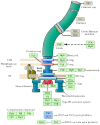Clinical Escherichia coli: From Biofilm Formation to New Antibiofilm Strategies
- PMID: 35744621
- PMCID: PMC9229135
- DOI: 10.3390/microorganisms10061103
Clinical Escherichia coli: From Biofilm Formation to New Antibiofilm Strategies
Abstract
Escherichia coli is one of the species most frequently involved in biofilm-related diseases, being especially important in urinary tract infections, causing relapses or chronic infections. Compared to their planktonic analogues, biofilms confer to the bacteria the capacity to be up to 1000-fold more resistant to antibiotics and to evade the action of the host's immune system. For this reason, biofilm-related infections are very difficult to treat. To develop new strategies against biofilms, it is important to know the mechanisms involved in their formation. In this review, the different steps of biofilm formation in E. coli, the mechanisms of tolerance to antimicrobials and new compounds and strategies to combat biofilms are discussed.
Keywords: Escherichia coli; biofilms; clinical importance; non-traditional approaches; resistance.
Conflict of interest statement
The authors declare no conflict of interest.
Figures







References
-
- Vert M., Doi Y., Hellwich K., Hess M., Hodge P., Kubisa P., Rinaudo M., Schué F. Terminology for Biorelated Polymers and Applications. Chem. Int. Newsmag. IUPAC. 2011;33:377–410. doi: 10.1515/ci.2011.33.2.25c. - DOI
Publication types
Grants and funding
- PI19/00478/Instituto de Salud Carlos III
- REIPI RD12/0015/0013/Spanish Network for Research in Infectious Diseases from the Instituto de Salud Carlos III together with the European Development Regional Funds
- REIPI RD16/0016/0010/Spanish Network for Research in Infectious Diseases from the Instituto de Salud Carlos III together with the European Development Regional Funds
- 2014-2020/European Development Regional Fund "A way to achieve Europe" and operative program Intel-ligent Growth
- COLCIENCIAS Scholarship program N. 756/Ministerio de Ciencia, Tecnología e Innovación (Colombia)
LinkOut - more resources
Full Text Sources
Other Literature Sources

